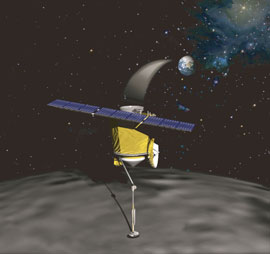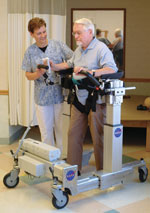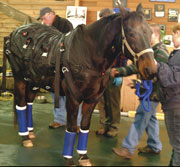| Skip to content | |||||
 |
|
||||
|
|
 |
||||||||||||||||
|
|
Maintaining strong relationships to yield ongoing technology transfer successes
Seeking new partnerships and negotiating multiple agreements for Goddard technologies are important components of an overall strategy of increasing the value of our innovations within and beyond the space program. Another important component is the continued nurturing of successful relationships in order to yield repeat agreements or successes now and in the future. The IPP Office’s personal approach to technology transfer agreements enables many partnerships to grow over time with continued benefits for both NASA and our partners.
During the 1990s, designAmerica* participated with Goddard in the development of the Advanced System for Integration and Spacecraft Test (ASIST) technology. ASIST is a real-time command and control system for spacecraft development, integration, and operations. designAmerica licensed ASIST from Goddard in October 2003, making it available as a commercial off-the-shelf (COTS) product. Today, ASIST has become the ground system of choice for successful satellite and instrument projects. Building on the dedication and hard work of the designAmerica team and the foresight and support of Goddard’s IPP Office throughout the licensing process, ASIST is well on its way to becoming the commercial success that was originally envisioned in its early days. For example, Northrop Grumman has chosen designAmerica and ASIST to be its basic rapid development component for its in-house project flight software development and avionics integration and test labs. This work benefits a range of satellites that the company is developing in-house, including NASA missions such as the Lunar Crater Observation and Sensing Satellite (LCROSS). With ASIST at the core of its development suite, Northrop Grumman has demonstrated impressive gains in automated development and testing. In this way, they have streamlined satellite development, and saved substantial mission dollars. In addition, designAmerica and ASIST were recently selected by Lockheed Martin to be the in-house integration and test (I&T) and mission operations system at its satellite production facility in Denver. For this project, ASIST will be both the development and the operations system for the RQ36 asteroid-rendezvous Discovery mission OSIRIS and the Mars Atmosphere and Volatile Evolution (MAVEN) mission for NASA, with a demon-strated cost savings of well over $3M for the ground system element. NASA’s licensing efforts and its continued interest in the designAmerica relationship is clearly reaping benefits and success for both organizations today—almost five years after the initial license was signed. (Editor’s Note: Sections of this story were adapted from text written by Thomas J. Green, president, designAmerica.) From human to animal rehabilitation: a long-term prognosis for the strength of the Enduro relationship
What began as hinge technology for robots and sounding rockets used in the space program has become a revolutionary rehabilitative device with a growing list of applications—thanks to the strength of the relationship between Goddard’s IPP Office and Enduro Medical Technology. In the 1980s, NASA required a technology that would facilitate mechanical isolation of sounding rocket assemblies as well as provide compliance for robots to grip or join objects. As part of this robotics research, the late James Kerley developed the cable-compliant joint (CCJ) technology, which provided customizable structural connections and selective, subtle cushioning, twisting, and alignment in six directions, allowing contact surfaces to be joined together. Not only did the technology meet NASA’s requirements, but it was readily clear that the subtle movement the technology facilitated could easily be extended to other applications. In the 1990s, researchers at Goddard integrated the CCJ technology into a patented walker that supports the pelvis and provides compliance that imitates hip joint movement. In 2003, Goddard licensed the technology to Enduro, which used the CCJ to develop the Secure Ambulation Mode (SAM) walker. The SAM rehabilitative devices have shown remarkable success, all documented and promoted by the IPP Office through Web feature articles, printed success stories, support at NASA events, and press releases. After establishing the device’s use and benefits for human rehabilitation, Enduro engineers engaged in discussions with doctors at nationally renowned veterinary hospitals. Interest among this community was high and convinced Enduro that the CCJ-based technology could also be incorporated into a rehabilitative device designed specifically for horses. Having kept in close contact with the IPP Office, Enduro found a second license agreement to be a natural extension of an already-strong relationship. So in February 2007, Enduro secured a new field-of-use license from Goddard to develop SAM-Equine. The company has developed a prototype of an equine version, and is currently testing the device on live horses.
|
||||||||||||||||
|
|||||||||||||||||


